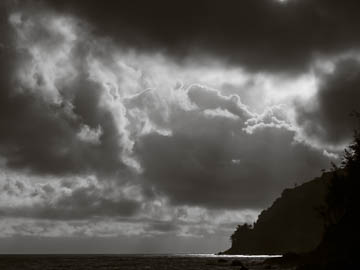Every Picture Is a Compromise
Lessons from the Also-rans
Most photography websites show the photographer's very best work. Wonderful. But that's not the full story of a creative life. If we want to learn, we'd better pay attention to the images that aren't "greatest hits" and see what lessons they have to offer. Every picture is a compromise — the sum of its parts, optical, technical, visual, emotional, and even cosmic – well, maybe not cosmic, but sometimes spiritual. Success on all fronts is rare. It's ok to learn from those that are not our best.
This is a series about my also-rans, some of which I've been able to improve at bit (i.e., "best effort"), none of which I would consider my best. With each there are lessons worth sharing, so I will.
Original digital captureWhy "dynamic range" is so important:Hawaii, on the shore during a massing of storm clouds. I particularly like the bright sun illuminating the water on the distant head of land. Note in the original exposure above how that shadow on the lower right corner is blocked down into total black. We can't even tell there are two heads of land and that leaves it odd that the beam of light illuminating the water is truncated. It's not visually logical. And this is where we are saved by the amazing dynamic range of today's sensors. I had to "expose to the left" to preserve the all-important highlights in the storm clouds. Fortunately, the wide dynamic range of the sensor allowed me to raise the shadow values and differentiate the two heads of land. And now the light in the water makes visual sense. The more dynamic range your camera can capture, the better. That said, you don't need to spend a fortune. This was shot using a Panasonic G2 — a micro 4/3 camera from 2010, pretty primitive compared to today's cameras. Even so, it helps knowing how to critically expose and knowing the capabilities of post-processing. |


